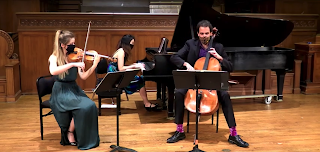from the Bandcamp Web page for the album being discussed
The latest release of performances by clarinetist Ben Goldberg is General Semantics, a trio album in which he is joined by reed player Geof Bradfield and percussionist Dana Hall. This is “pre-pandemic” music, since the recording sessions took place on November 30 and December 1 in 2018. The Delmark Records album was originally scheduled for release this past September, but that release was delayed until the beginning of December.
The album title is also the title of the sixth of the eleven tracks. Since the study of semantics played a major role in my previous life as a researcher in computer science, artificial intelligence, and multimedia, I invested a fair number of “brain cycles” in trying to find a story behind that title, all to no avail. I was reminded of when Goldberg had formed a quartet in January of 2012 called the Ben Goldberg School, whose first (and only, if I am not mistaken) release was entitled Vol. 1: The Humanities; but I suspect that the only trait shared with this earlier album is an imaginative approach to track titles.
Far more interesting is the diversity of sonorities summoned up by the two reed players. Both are multi-instrumentalists, but Goldberg sticks to his B-flat clarinet on all but three of the tracks. Bradfield, on the other hand, plays both soprano and tenor saxophone and bass clarinet. Goldberg’s only other instrument is his contra-alto clarinet. The primary assets of the album involve these players’ capacity of elaborate two-part counterpoint, often with the two lines interleaving in and among each other. In that context Hall substitutes for the usual bass in providing a “continuo” with his suite of percussion instruments.
While all of this inventiveness is refreshingly original, there are three tracks whose origins can be found in the compositions of others. Thus Bradfield prepared an arrangement of Duke Ellington’s “Half the Fun,” which provided a platform for Goldberg’s contra-alto work. Bradfield also arranged Hermeto Pascoal’s “8 de Agosto.” The Brazilian composer had written a song for every day of the year, meaning that everyone would have a tune for his/her birthday. Bradfield chose to arrange this particular date, because it is Goldberg’s birthday. Finally, Bradfield and Goldberg joined forces in improvising on a “two-level” appropriation, Steve Lacy’s performance of the tune “Air,” composed by Cecil Taylor.
Like the title track, there are other selections with playfully enigmatic labels (such as “345”). However, at the end of the day, this album is all about the capacity for invention among an unconventional collection of instruments. There is definitely a prevailing sense of playfulness behind all that invention, making for a highly engaging listening experience.



















